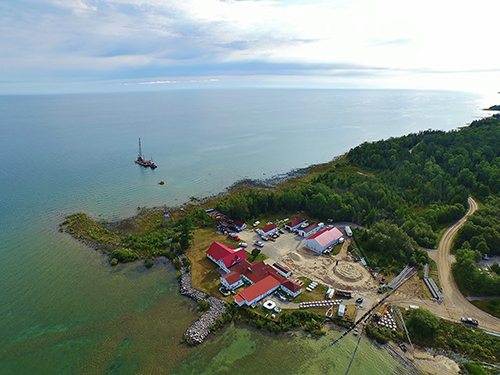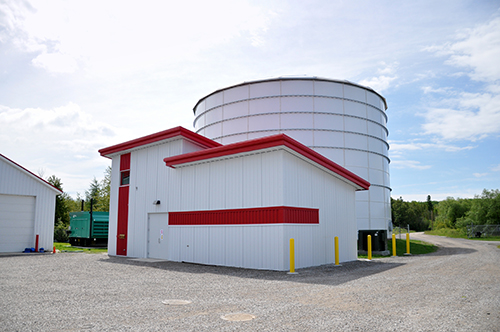

USGS scientist takes aim at Great Lakes invaders
Rising Higher: A Research Lab Built from the Ground Up - Part 2
Great Lakes Researchers Go Down Under
Rising Higher: A Research Lab Built from the Ground Up - Part 1
A Monograph on Ciscoes of the Laurentian Great Lakes and Lake Nipigon
WATCH: Acoustic Telemetry Provides In-Depth Look into Fish Behavior
Eel-Ladder Style Traps: A New Lamprey Control Tool
A Lampricide Treatment: Up-Close
Lamprey Nativeness Claims Annulled by Commission's Eshenroder
A Population at the Edge: American Eel Declining at the Extremes
Celebrating 60 Years of Successful Sea Lamprey Control, Science, and Cross-Border Collaboration!
Great Lakes Scientists Use Acoustic Telemetry to Reveal the Secret Lives of Fish
Hammond Bay Biological Station: The Nexus for Research and Restoration on the Great Lakes
Big Consequences of Small Invaders
New Sea Lamprey Estimates Suggest a Dramatically Decreased Population
Conducting Research through Cooperative Partnerships: The PERM Agreement
Living on the Edge: A Closer Look at Coastal Communities
Asian Carp: The War Isn't Over
Managing the Lake Huron Fishery
Understanding Sea Lamprey: Mapping the Genome and Identifying Pheromones

- A Lampricide Treatment: Up-Close
- Eel-Ladder Style Traps: A New Lamprey Control Tool
- WATCH: Acoustic Telemetry Provides In-Depth Look into Fish Behavior
- A Monograph on Ciscoes of the Laurentian Great Lakes and Lake Nipigon
- Meet the Fleet: GLFC-USGS Partnership Makes Waves with Newly Renovated Deepwater Science Vessel Fleet
- Rising Higher: A Research Lab Built from the Ground Up. Part 1.
Rising Higher: A Research Lab Built from the Ground Up
A New Laboratory to Advance Invasive Species Control
Scores of invasive species have found their way into our Great Lakes, creating a significant challenge for natural resource managers who must respond. Although many of these new species do not pose a serious threat, some become "invasive" and inflict significant costs to both the economy and the environment. Natural resource managers need scientists to develop a strong understanding of these new species, along with strategies and tools to aid in managing or eradicating them.
To meet this need, a state-of-the-art invasive species laboratory is being built on the shores of Lake Huron at the USGS HBBS. The biological station is one of seven field stations of the USGS Great Lakes Science Center, and is operated via a decades-long partnership with the Great Lakes Fishery Commission.

HBBS has a rich history of research on aquatic invasive species, particularly sea lampreys, which are ancient, parasitic fish that devastated Great Lakes fisheries in the mid-1900s. Much of the pioneering research on sea lamprey control occurred at HBBS, including development of lampricides, the primary control technique. The sea lamprey control program in the Great Lakes is recognized internationally as one of the most successful, wide-scale, science-based invasive species programs in the world. The program has achieved a 90 percent reduction of sea lamprey populations in most areas across the vast Great Lakes basin, which saves more than 100 million pounds of fish per year.
The new 7,600 square foot laboratory facility at HBBS will provide a 21st century platform for research on invasive species and is expected to attract the world’s top invasive species scientists. The new laboratory will replace an aging facility of the same square footage constructed piecemeal over the course of five decades.
The new facility will include laboratory space for chemistry applications, physiological research (i.e., the study of how organisms function), and bioassays (i.e., studies which assess the effect of various treatments on organisms). The facility will also contain multiple raceways that will serve as experimental streams where researchers can test techniques before application in the wild. A one-million gallon water tank, pump house, and pipeline from Lake Huron will supply water to the raceways and the many fish holding tanks in the new facility.
After the new laboratory facility is completed, the old laboratory facility, built just feet from the water, will be demolished. During the final stage of construction, part of the main building will be renovated to include an interpretive entryway designed to educate the hundreds of children and adults who visit HBBS each year.
PART 1: Water Tank & Pump House Construction
| Description: | Watch as the USGS Hammond Bay Biological Station water tank and pump house are constructed from the ground up! This short video features time lapse photography of the 1-million gallon water tank and pump house constructed to supply water to a state-of-the-art aquatic science laboratory. | |
| Source: | USGS | |
To operate an aquatic science lab, you need water—A LOT of water—because water is the lifeline of all aquatic organisms. The new laboratory facility at HBBS will house dozens of tanks capable of holding thousands of aquatic organisms. The new facility will also offer two large raceways—forty-feet long, ten-feet wide, and three-feet deep—where researchers can simulate realistic stream conditions, ranging from a babbling brook to a raging river. How will this water be supplied? Much like towers are used to supply municipal water, water to the new laboratory will be supplied by a water tank—a really big water tank—holding one-million gallons of Lake Huron water.
Part 1 of the time lapse video series shows the construction of the one-million gallon water tank as it rises from the ground. The build starts with assembly of the top of the tank, which is pushed higher and higher as successive layers of the tank wall are installed beneath. Concurrent with construction of the water tank, a new water intake pipeline is put in place to draw water from 45-feet deep in Lake Huron, serving as a second intake line along with a pre-existing pipeline which draws water from 75-feet deep. The video concludes with the building of a state-of-the-art pump house which will be used to electronically control water flow from the lake to the tank, and from the tank to the new laboratory. The water tank will be filled using three 20-horsepower pumps, each capable of pumping water at a rate of 750-gallons per minute, roughly equivalent to the rate that water is sprayed from a deluge gun (water canon) on top of a firetruck.
The next phase of construction will be the removal of old storage buildings to make way for the new laboratory. Be sure to check the GLSC website regularly for updated videos as each construction milestone is achieved! To learn more about the research that will be completed in the new laboratory, visit the Hammond Bay Biological Station and Great Lakes Fishery Commission websites.




